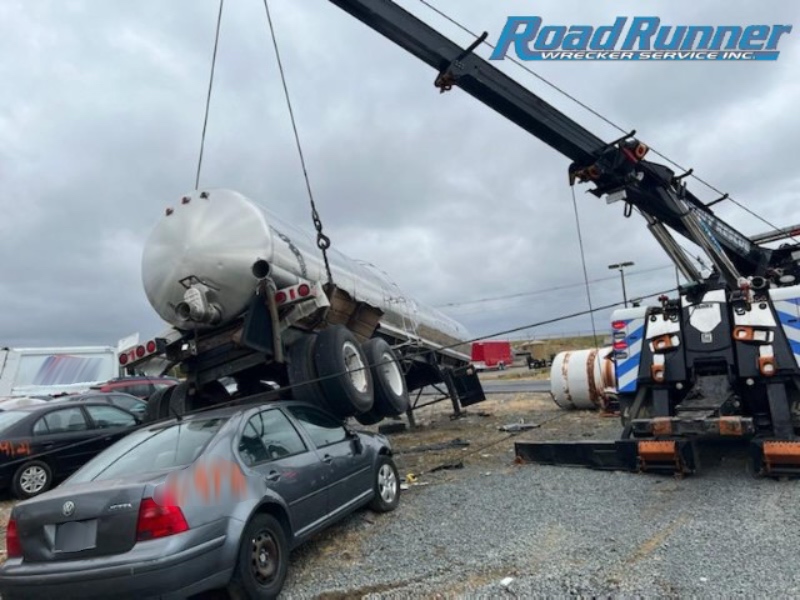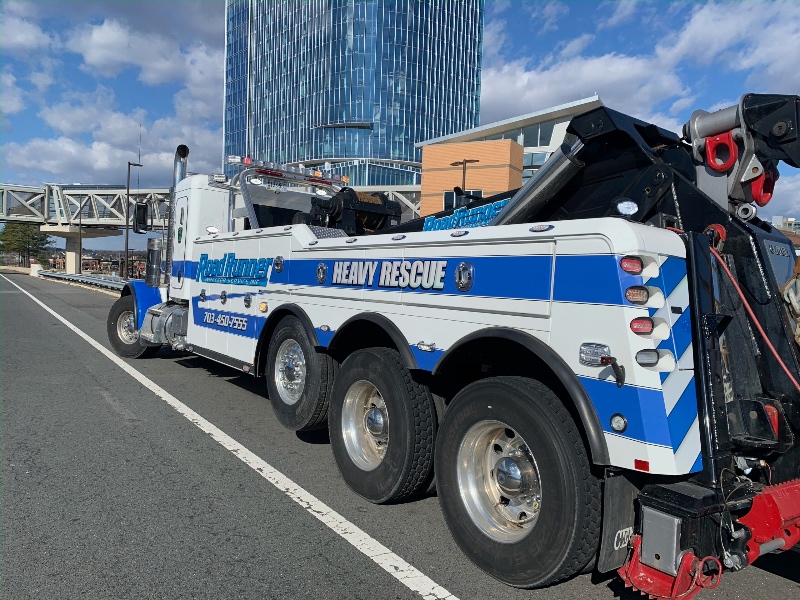Towing Capacity Is Based on Numbers, Not Assumptions
Towing capacity is one of those things people often misjudge. Some drivers assume a tough-looking rig can handle anything, but that assumption can lead to serious problems. For I-66 heavy towing, calculating towing capacity accurately is a required step in the process. Too much weight strains the transmission, stresses the brakes, and disrupts steering. On These issues can escalate fast. A tow should always begin with verified numbers, not estimates.

Start With the GVWR
The Gross Vehicle Weight Rating (GVWR) defines the maximum weight a vehicle can carry, including cargo, fuel, and passengers. This is the foundation for determining how much a vehicle can safely manage.
Calculating the payload involves subtracting the curb weight from the GVWR. That final number tells how much additional weight the vehicle can carry.
- Curb Weight: What the vehicle weighs empty.
- Payload Capacity: The allowable weight inside the cab or bed.
- Tongue Weight: The weight transferred from the trailer to the hitch.
A trailer may be within legal limits, but if the tongue weight exceeds what the vehicle can handle, the setup becomes unsafe. These details matter during every I-66 heavy towing or other towing job we undertake. Stability and control are always critical.
GCWR Tells the Full Story
Gross Combined Weight Rating (GCWR) is the maximum allowed weight of the towing vehicle and trailer together. It’s the number that defines safe towing limits.
How the max trailer weight is calculated:
- Take the GCWR listed by the manufacturer.
- Subtract the truck’s actual loaded weight.
- What’s left is the allowable trailer weight.
For example, a truck with a 40,000-pound GCWR and a loaded weight of 22,000 pounds can tow 18,000 pounds. That number defines what’s safe and legal for the route ahead.
Axles and Brakes Are Just as Important
Axles have their own limits, noted as the Gross Axle Weight Rating (GAWR). Even if the total load falls within the GCWR, uneven distribution across axles can cause premature wear or failure. Balanced loading is essential.
Braking performance changes with weight. Towing more weight increases stopping distance. Trailer brakes must be correctly configured, and all components need regular testing. For every I-66 heavy towing job, preparation should include a full brake inspection before departure.
Terrain and Conditions Change Everything
Manufacturers calculate towing capacity based on ideal conditions. But towing rarely happens under perfect circumstances. Road grade, weather, and traffic patterns all affect how a load behaves in transit.
A trailer setup that feels manageable on level ground may perform very differently on an uphill grade or in wet weather. For I-66 heavy towing, terrain and conditions should always influence the final go/no-go decision.
Stick to the Checklist
Before towing begins, a checklist helps confirm that every part of the setup meets the requirements for the route and the load. That checklist includes:
- Confirming GVWR and GCWR
- Weighing the tow vehicle with gear and crew
- Calculating remaining trailer capacity
- Checking axle weight distribution
- Inspecting brakes, lighting, and trailer connections
This kind of preparation isn’t optional. It ensures the vehicle stays compliant and safe from point A to point B.

FAQ: Understanding Towing Capacity
1. What is towing capacity and why does it matter?
Towing capacity is the maximum weight your vehicle can safely pull. Exceeding it strains the engine, transmission, brakes, and suspension — often leading to breakdowns, accidents, or expensive recovery jobs.
2. How is towing capacity actually calculated?
It starts with the manufacturer’s Gross Combined Weight Rating (GCWR):
- Find the GCWR in the owner’s manual.
- Weigh the fully loaded tow vehicle (including passengers, fuel, tools).
- Subtract the vehicle’s loaded weight from the GCWR.
- The result is the maximum safe trailer weight.
3. What’s the difference between GVWR, GCWR, and GAWR?
- GVWR: Max weight the tow vehicle can carry (vehicle + passengers + cargo).
- GCWR: Max combined weight of the tow vehicle and the trailer.
- GAWR: Max weight each axle can safely handle.
All three numbers must be within limits for a safe tow.
4. How does tongue weight affect safe towing?
Tongue weight is the downward force from the trailer on the hitch. It should be about 10–15% of the trailer’s total weight. Too little causes trailer sway; too much overloads the rear axle and reduces steering control.
5. Why can a setup that looks “fine” still be unsafe?
Published ratings assume ideal conditions — level roads, moderate temperatures, properly distributed loads. Steep grades, wet pavement, high winds, or heavy traffic can all push a borderline setup past safe limits.
6. Does road terrain affect how much I can tow?
Yes. Long uphill grades overwork the engine and transmission, while downhill stretches put extra stress on the brakes. For I-66 heavy towing, we always consider terrain before approving a load.
7. Why is axle weight distribution so important?
Even when the total weight is legal, too much load on a single axle can cause suspension damage, tire blowouts, or steering problems. Properly balancing the load protects the truck, the trailer, and everyone on the road.
8. How do trailer brakes factor into towing capacity?
The heavier the load, the more crucial it is that the trailer’s own brakes are functional and adjusted. They reduce stopping distance and prevent overheating of the tow vehicle’s brakes, especially on hills.
9. What’s on a professional pre-tow checklist?
- Verify GVWR, GCWR, and GAWR
- Weigh the tow vehicle with crew and gear
- Calculate remaining trailer capacity
- Check axle distribution and hitch rating
- Inspect brakes, tires, and lighting
This step prevents last-minute surprises and keeps the haul compliant.
10. Why trust Road Runner Wrecker Service for I-66 heavy towing?
Because we:
- Have decades of experience handling heavy, complex loads safely on I-66 and I-495
- Confirm all weight ratings before every job
- Bring the right equipment for the route and conditions
- Inspect brakes, hitches, and safety gear prior to departure
I-66 Heavy Towing: Road Runner Wrecker Service Does the Math
Road Runner Wrecker Service uses weight ratings and mechanical specs to guide every I-66 heavy towing job. Every calculation is confirmed, every component is checked, and every haul starts with the facts.
I-66 heavy towing and Centreville Farms heavy towing requires more than horsepower or sheer size. It depends on knowing the numbers, understanding the route, and operating with discipline.
Before any tow, we make sure the equipment, load, and route all line up. That’s the approach that keeps everything moving safely.
